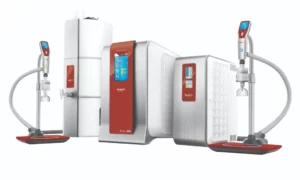Are you prepared to embark on a thrilling voyage into the expansive realm of space? Prepare yourself to have your creativity sparked as we delve into the extraordinary realm of upcoming space technologies. From astonishing advancements in spacecraft to groundbreaking revelations, this article will take you on an unforgettable journey, investigating limitless potentialities in our pursuit of knowledge and exploration beyond the confines of Earth.
Introduction to Space Technologies
Space technologies are in a constant state of evolution, yielding new findings on a regular basis. In order to stay abreast of the latest progress, it is essential to grasp the fundamentals of space technology. This introduction will provide a concise overview of some of the most pivotal space technologies and their practical applications.
Among the most vital space technologies are satellites. Satellites serve a multitude of purposes, encompassing communication, navigation, and weather forecasting. They are also indispensable for Earth observation, enabling us to monitor phenomena such as deforestation and climate change.
Another key space technology is rockets. Rockets are employed to propel spacecraft into Earth’s orbit or to other celestial bodies in our solar system. They can also facilitate the deployment of payloads, such as satellites, into orbit.
Crafted to function in the inhospitable space environment, spacecraft must endure extreme temperatures, radiation, and vacuum conditions. Equipped with sophisticated instruments, spacecraft are capable of fulfilling their intended missions, whether that involves conducting research or capturing imagery.
The International Space Station (ISS), a collaborative effort among numerous nations, affords astronauts from around the world the opportunity to reside and labor in space for extended durations. The ISS serves as a testing ground for innovative space technologies and has played a pivotal role in advancing our comprehension of human adaptation and operation in prolonged space missions.
As we persist in our exploration of the solar system and beyond, novel technologies will be requisite to facilitate these endeavors.
Merits of Space Technologies
Space technologies offer a plethora of advantages. They furnish insights into distant planets and stars, and they facilitate global communication. Moreover, they contribute to safeguarding our planet against potential hazards posed by asteroids and comets.
Present and Future Applications of Space Technologies
A myriad of potential applications for space technologies could yield considerable influence in the near future. One domain under exploration involves utilizing satellites as early warning systems, capable of furnishing advance notice regarding natural calamities like hurricanes or tsunamis. Another potential avenue is the extraction of space-based resources to stimulate economic growth, encompassing the extraction of minerals and metals from asteroids.
Furthermore, space technologies are under development for national security purposes, encompassing threat surveillance and communication provisioning during crises. As these and other applications continue to mature, it is foreseeable that space technologies will play an increasingly pivotal role in our lives.
Challenges Encountered in Space Technology Development
The space environment is distinctly challenging, posing obstacles to the creation of technologies that can withstand its rigors. The vacuum of space presents complications for many technology types, while the extreme temperatures prevalent in space can inflict harm upon equipment. Radiation in space also constitutes a concern, as it can compromise both human health and technological integrity.
Another hurdle in the pursuit of space technologies lies in the domain of cost. Space exploration is a resource-intensive undertaking, and the development of innovative technologies can be financially demanding. Additionally, the transition of new technologies from terrestrial efficacy to functionality in space is not straightforward, with many systems that excel on Earth exhibiting performance discrepancies in space.
Despite these trials, numerous captivating advancements are unfolding within the realm of space technology. Fresh materials and manufacturing techniques are emerging, holding the potential to mitigate certain challenges associated with the space environment. The evolution of space technologies is ongoing, with perpetual obstacles to surmount.
Role of International Organizations in Advancing Space Technologies
The potential for space exploration and utilization is virtually boundless. To ensure the responsible and secure execution of these activities, a range of international organizations have been established to foster the development and utilization of space technologies.
Among these is the United Nations Office for Outer Space Affairs (UNOOSA), entrusted with the mission to “promote international cooperation in the peaceful uses of outer space.” UNOOSA collaborates with diverse partners to formulate policies and initiatives that empower nations to leverage space technologies for the collective benefit of humanity.
Another pivotal international organization is the European Space Agency (ESA), an intergovernmental entity that fosters collaboration between European nations in the realm of space exploration. ESA’s principal objective revolves around shaping Europe’s space-oriented future by spearheading new technologies and pioneering cutting-edge research.
Then there’s NASA—the National Aeronautics and Space Administration of the United States of America. NASA assumes responsibility for America’s civilian space program, in addition to driving scientific and technological research within aeronautics and aerospace. NASA’s contributions are pivotal in international endeavors aimed at the exploration and utilization of outer space, and the agency boasts numerous significant accomplishments in this domain.
These are but a few instances of the multitude of international organizations working to propel space technologies forward. Collectively, they are instrumental in fostering a promising future for humanity, wherein we can all partake in the fruits of space exploration.
Potential Benefits of Investing in Space Technologies
Investing in space technologies offers a plethora of prospective advantages. Some of these advantages encompass:
- Enhanced communication and navigation systems.
- Deepened comprehension of our planet and its resources.
- More effective utilization of energy and other vital resources.
- Progress in medical research and treatments.
- Fresh prospects for commercial enterprises and industries.
Each of these merits bears significant import, and in synergy, they possess the potential to revolutionize global existence and operation. As we perpetuate our exploration of space’s limitless potential, it remains crucial to channel investments into the technologies that will propel us towards these aspirations.
Conclusion
From the deployment of solar sails on robotic probes to the establishment of human-made habitats in the depths of space, the horizon of space technology’s future appears more exhilarating than ever. As our boundaries expand and our limits are challenged, it’s essential to recognize that today’s accomplishments are but the initial steps scientists and engineers, through the development of novel technologies, will usher forth an even broader spectrum of possibilities for us to unearth. With an immensely promising future on the horizon, the potential of our achievements knows no bounds when we capitalize on our full capabilities.



































